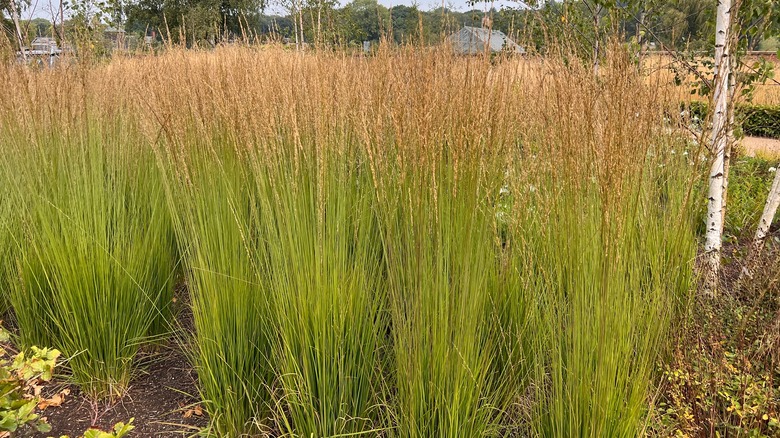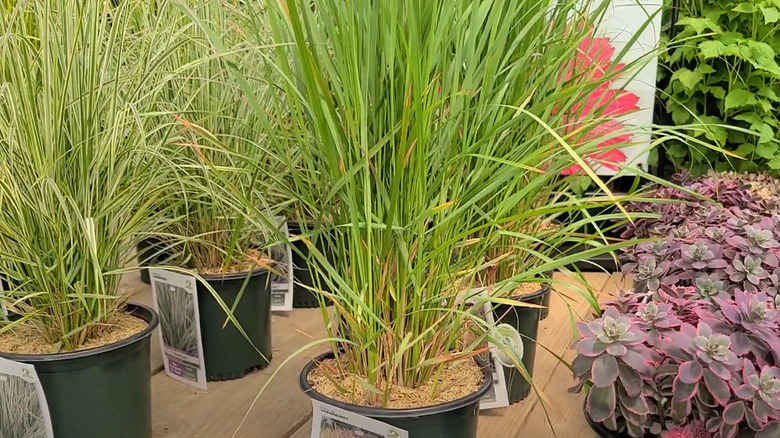Are you on the quest for ornamental grasses for gardens that offer the perfect combination of deer resistance and aesthetic allure? Now, picture a tall, graceful plume waving lightly in the breeze amidst your garden, with intricate seed heads reflecting the sun’s glow. Meet Karl Foerster Feather Reed Grass, an early bloomer that offers an aesthetic uplift without bending to the whims of four-legged garden marauders like deers.
Botanically known as Calamagrostis x acutiflora “Karl Foerster,” this easy-to-propagate-and-maintain grass boasts slender, erect stems typically reaching stately heights up to 6 feet. The hypnotic sway of its fluffy, feather-like plumes that transition from green to golden brown in fall creates a breathtaking spectacle. Not to mention that it wears a badge of distinct honors, counting its award as the Perennial Plant of the Year 2001 by the Perennial Plant Association among them.
The secret to infusing vibrancy into your garden with this ornamental grass often boils down to understanding its growing conditions. It prefers full to half sun and thrives in loamy, well-drained soils while accommodating varied pH.
More on the Karl Foerster grass benefits for your yard

One of the most exciting features of Karl Foerster Feather Reed Grass is that it provides year-round interest, with stunning blooms from early summer, showy seed heads that persist through winter, and a captivating golden fall color. But the magnificence doesn’t end with aesthetics. If you’re the kind that wages a constant war against rabbits and deer and the havoc they wreak on our gardens, here’s your knight in shining armor. Chat with gardeners, and they’ll narrate tales of damaged plants and hours lost to devising clever interventions. Not anymore, for Karl Foerster Grass exhibits an impressive resistance to these two intruders.
The Karl Foerster Grass checks the three golden boxes most gardeners desire: low maintenance, excessive growth, and robust hardiness. You’ll appreciate that it flourishes in diverse soils with minimal tending. And do you fancy a privacy screen or some vertical drama in your garden? Well, the fast-growing Karl Foerster’s got you covered. Not to mention that it’s hardy across USDA zones 5 to 9 and isn’t prone to developing diseases.
Consider it the multi-talented maverick of your landscape, acing everything from mass plantings to patio pot containers. To sweeten the deal, Karl Foerster grass seed heads draw birds during winter with the irresistible combo of nourishment and shelter. And once established, all this beautiful ornamental grass for yards needs is an annual trim in late winter.
How do you propagate Karl Foerster feather reed grass?

YouTube
Propagating the colorful deer-resistant plant that is Karl Foerster grass doesn’t involve seeds, thanks to their sterility. Instead, we divide mature clumps in early spring or early fall during active growing times, providing a generous establishment window before extreme weather strides in. To divide Karl Foerster Feather Reed grass, grab a spade and carefully dig around and underneath the plant, ensuring no root damage while lifting it from its earthy cradle. Then, divide the clump into smaller sections, ensuring each offshoot has a robust blend of roots and shoots.
Karl Foerster feather reed grass fancies a sun-soaked spot with a minimum of six hours daily. Partial shade is entertained, but ensure at least two hours of direct sunlight. And while its preference lies in moist, well-draining soil, this versatile performer does well in loamy, sandy, and clay soils. The post-transplantation phase requires frequent watering to help the newly planted Karl Foerster feather reed grass establish its roots in the new home. Following establishment, hydrating turns less chaotic, as the grass shows some drought tolerance.
As for fertilizing, an organic mulch usually hits the mark. Potting is welcome, though be mindful of drainage. Opt for a larger container with drainage holes, or go rustic with the porous terracotta pot. Beware of the oversize temptation; a large-than-necessary pot facilitates water retention that could spell fungal disaster.



